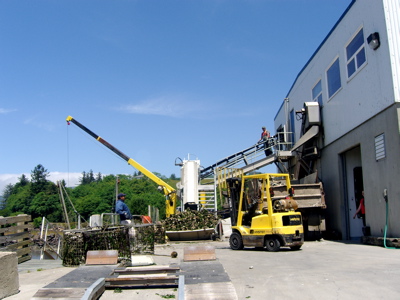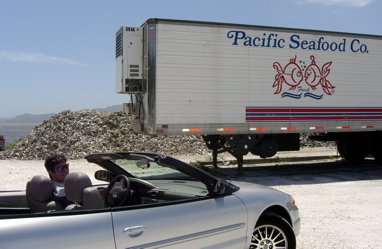Seattle-San Jose Road Trip
Heat Wave (Monday)
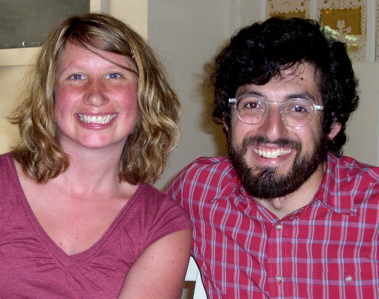 Monday
morning we were up early, and at Pike Place Market by 9:15, which was great
because it wasn’t very crowded and they were just opening up—we
received abundant samples of chocolate-covered pecans and cherries and jams
and jellies, and mangoes and beef jerky and cheese curds and hazelnuts. (Several
friends who had gone to the market Saturday afternoon said that the samples
then were not quite as forthcoming, though the crowds certainly were.)
Monday
morning we were up early, and at Pike Place Market by 9:15, which was great
because it wasn’t very crowded and they were just opening up—we
received abundant samples of chocolate-covered pecans and cherries and jams
and jellies, and mangoes and beef jerky and cheese curds and hazelnuts. (Several
friends who had gone to the market Saturday afternoon said that the samples
then were not quite as forthcoming, though the crowds certainly were.)
We bought a sweet tamal for breakfast, followed by six fresh donuts (powdered sugar, cinnamon, plain cake), and dried fruit logs (apricot was the best, rolled like a thin cigar in coconut or almonds). We watched the fish-throwing and generally walked around happily (though it was getting hotter and hotter, now 92 or so) until 10:30 when we started walking back down Western Ave. to the Boat Street Cafe. We got there at 11:00 for Ben and Lise’s post-wedding lunch—there were good sandwiches, salad, and bread pudding, and we had a chance to chat with Ghaz, Alyssa, Dan, and Joel before everyone departed for the weekend. At left, the bride and her new brother-in-law Dan at the lunch. Below right, Robert, Ben, Lise, and Lise's brother Alex all shake hands goodbye.
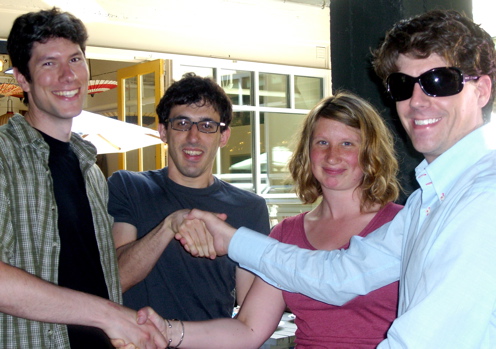 After
we said goodbye to everyone there, we drove Joel south to Portland, since
he was going to take the train there to meet friends, but the train wasn’t
running and was instead putting people on busses. The ride gave us all a chance
to talk more, which was very nice, despite the escalating heat (114 degrees
according to the car thermometer, and of course the top was down and the sun
high).
After
we said goodbye to everyone there, we drove Joel south to Portland, since
he was going to take the train there to meet friends, but the train wasn’t
running and was instead putting people on busses. The ride gave us all a chance
to talk more, which was very nice, despite the escalating heat (114 degrees
according to the car thermometer, and of course the top was down and the sun
high).
Somewhere along I-5, we stopped at a rest area for a cold drink, but there was no soda machine, just coffee in a pot (“donations welcome,” read the sign) and when Joel asked about soda, the funny old man (kind of reminiscent of a toothless Vermonter himself) in a hut said cryptically, “We’re not allowed to sell soda. But I can mix you up a drink in here,” indicating an industrial-sized jug of generic fruit punch next to him. Joel politely declined.
Just after crossing the bridge into Oregon, and following a confusingly long and convoluted series of signs for a visitors’ center, we had another frightening encounter with a local when we attempted to get a small map of Portland so we could locate the train station in order to drop off Joel.
Robert, Joel, and I were standing in the visitors’ center (which, incidentally was rather a grand name for the cramped stall shoved into the corner of a mall whose biggest store seemed to be an imitation 7-11). As we were scanning the racks of tourist brochures, the woman staffing the center emerged from behind a counter and accosted us.
“What do you need?” she asked.
“Would any of these have a map that shows the train station?” I said.
“No,” she said, “but I have a whole map of Portland that does.”
I smiled and waited for her to produce the map. She retreated back behind her counter, but no map appeared.
“Do you want that?” she asked.
“Oh, yes, that would be helpful.”
“How long are you in Portland for?” she asked as she rustled around in a drawer, presumably now getting out the map.
“Just this afternoon,” Joel said.
The woman ignored him. “Now, this isn’t a fancy map,” she said, taking out a photocopied copy-of-a-copy map, but not letting it out of her hands yet. “It’s not one of those fancy maps you’d pay $3 for. Some people expect that, you know.”
“No, we don’t. I think this would be fine,” I said.
“What’s the scale on that map?” Robert asked.
We all ignored him.
“The train station is here,” the woman said, making a dot, “and we’re here.”
“Oh, thank you,” I said, “I think we can figure it out from. . .”
“Let me give you directions,” she said, still holding onto the map. “Where are you from?”
“New York,” said Joel.
“Boston,” said Robert.
“Both,” I said.
The woman gave me a funny look. “My mother was from New York,” she said. “Elmira—do you know where that is?”
“Oh, that’s near Ithaca,” I said. “There’s a wonderful ice cream place there.” I smiled at my own memory of the homemade ice cream cones in the black raspberry dip.
“That’s right,” the woman said. “I always say New York has the best ice cream. I great up in Pennsylvania, and the ice cream there just isn’t as good.”
“Well of course it isn’t,” I said. “In New York the ice cream is custard-based, but Philadelphia-style ice cream is completely different—no eggs, much less rich.”
The woman gave me another funny look. “Do you sell ice cream?”
“No, I just like it, and I make it a lot at home.”
“Well, that’s the truth—New York has the best ice cream. How long are you in Portland for?”
“Just this afternoon,” Joel said.
“Oh, that’s not long,” the woman said. “You won’t have time to go to the Nike factory. You know that’s right here in Portland.”
“Yes, in Beaverton, just to the west,” I said. Jef’s family lives in Beaverton, and we were planning on meeting his brother Max there for sushi after dropping Joel off.
The woman gave me yet another funny look. “What do you do?” she asked, as though I were perhaps a Nike-ice cream corporate spy.
“I teach English.”
“And you?” she pointed at Joel.
“I teach economics.”
“And you?” she pointed at Robert. “You’re not a teacher—I used to be a teacher, and a nurse, too, but I used to be a teacher, and you’re not one.”
“Can you smell them?” Robert asked.
She ignored that.
“Um, I do finance,” Robert said.
“How long will you be in Portland?” she asked.
“Just this afternoon,” Joel said, “and really, I think we’re okay with the map, we can get from here to the train station.”
“All right, let me give you directions,” she said. “Start here, and then go down MLK street. That’s ‘Martin Luther King’ street—every city has one of those. Then you’re going to continue down it past the trailer park and then curve around and. . .”
Her directions went on for another three or four sentences, but I had to stop listening after “trailer park” because I was afraid I was going to laugh. I hadn’t been able to look at Joel or Robert throughout this entire conversation as it was. Finally, she handed over the map.
Something she had said during the process of giving directions had reminded her of a story about her granddaughter, who was at a computer animation camp in Florida now but might come to another one in Portland next year. I tried not to listen. All three of us were backing away, now that we had the map, and thanking her profusely.
“Door,” I said to Robert, barely making a sound, but indicating a sidedoor that we hadn’t come in through but which was blessedly close.
“Air conditioning,” he said, so we kept backing out, the long way, until we were out of sight of the woman and into the imitation 7-11 (which didn’t even have imitation slurpees—Robert asked) for a few more seconds of air conditioning.
Back in the car, we all had to breathe deeply.
“Wow,” said Joel.
“Yep,” I said.
“So how do we get to the train station?” Robert asked.
We drove down MLK street until the street started to turn, and we were wondering if we were still going in the right direction, when Joel yelled out, “Get your teeth capped in gold here!” Apparently, we had hit the trailer park, and he was just reading aloud a billboard.
We got Joel to the train station about half an hour before his friend was supposed to arrive to meet him, and we stood on the curb talking for awhile before saying goodbye. I was somewhat drained from the immense heat combined with our encounter with the woman.
After that, there was nothing for it but to go to Powell’s, the famous Portland bookstore, which was nice but not really the best bookstore I’ve ever been in—I prefer Mo’s in Berkeley or even Avenue Victor Hugo in Boston for just poking around for cheap used books, Amazon or the BPL catalogue online for finding specific books and authors, and the New England Mobile Book Fair for finding Victorian novels (because you can search by publisher). Still, I found an out of print Mary Augusta Ward novel and an out of print biography of her, by John Sutherland, which came out to $10 for the two.
Dinner was at a conveyer-belt sushi place in Beaverton, with Max. The $.80 apiece salmon nigiri won my heart—badly formed but fresh and good—and we spent about $50 on a lot of food for three people. Max filled us in on everything he’s been doing in the last year: playing Warcraft until a thunderstorm fried his computer, writing a fantasy novel, growing cherries (he sent us back with a bag of dried cherries for us and two for Jef), and looking for a job, any job, to start earning money to pay back student loans.
Max took us to another Uwajimaya store after dinner—it had a different mix of stuff than the one in Seattle, but it was of course fun to walk through. We got mochi, hung out in parking lot eating it and talking. then drove west on 26 and west again on 6, heading to the coast.
It was a very very dark curvy drive, with nothing along the way except dark forest, and the temperature very quickly dropped to about 65 degrees—quite the change in weather.
As soon as the horrible twisty forest road ended, and we hit Tillamook, we stayed in the first hotel we saw, checking in around 10:30 at night—at $59 plus tax, with no internet access, but a comfy bed and pillows and frighteningly fierce water pressure, it was neither the best nor worst place we’ve stayed.
Oregon, Part 1 (Tuesday)
We were at the Tillamook cheese factory by 9am (strangely, there was only us and some senior citizens there that early) for a great free tour, a breakfast of fudge and cheese samples (after eating Max’s cherries with some dry cereal). We then had a scoop of Tillamook coffee-almond-fudge ice cream in a very nice $1.50 cone for breakfast dessert, and we bought a marionberry yogurt smoothie for later.
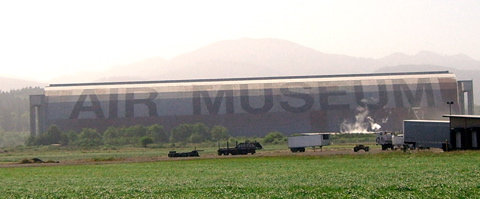
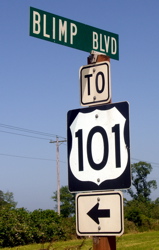
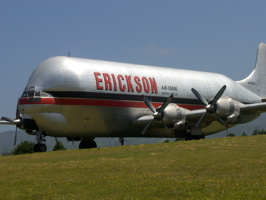
Next was just a mile or so south to the Tillamook Air Museum—a WWII blimp hanger just south of town, with fabulous old restored planes, mostly WWII-era, nearly all in flying condition and leaking a little oil. Robert and I love air museums, and it was a great place to wander around. Biplane rides were offered too, but we passed. Above, you see the blimp hanger from the outside, and you see the street sign nearby. You also see a specially-modified extra-fat (I think they would say "wide") plane parked outside the museum. Below you see Robert near the F-14 they had (flyable, of course) and then me and Robert in the F-14 simulator near it.
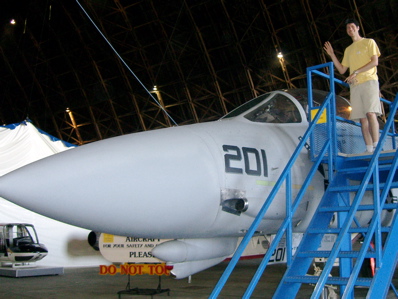
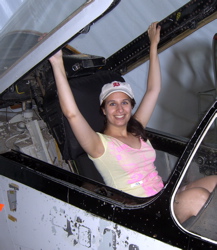
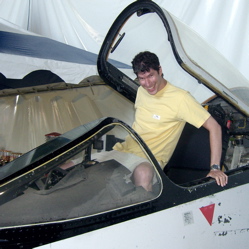
In the gift shop, I bought socks with labeled vintage planes on them—take that, Valentina (we’ve had a cute sock contest going for a couple years now). Below, you see pictures of us and our favorite WWII planes there, plus a view of the blimp hanger from the inside out (it's the world's largest completely wooden structure, according to the museum).
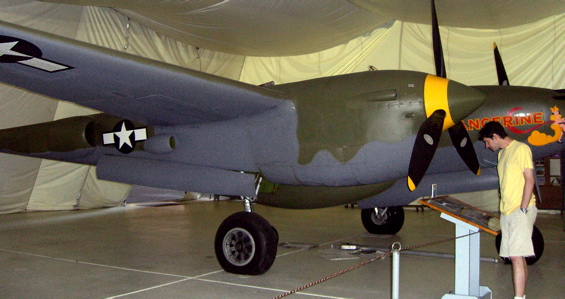
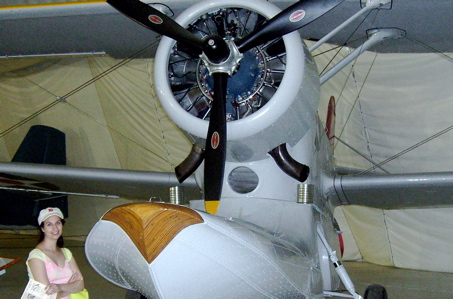
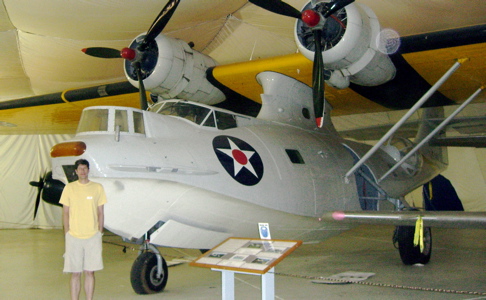
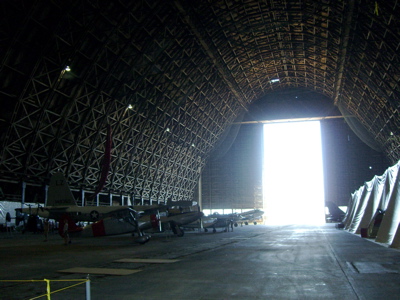
After the museum, we doubled back four miles (eight round-trip) out of our way to Bay City, just a little north on 101, to go to Pacific Oyster for lunch, for neat views of oyster processing plant, and fabulous food. We ate a smoked salmon lollipop (for dessert), an oyster burger, a mini order of “grilled” (pan-fried lightly breaded) oysters and chips and cheese-garlic bread, four oysters on the half shell (2 petite, 2 medium—both of them 2+ inches long, huge and meaty and deliciously unlike east coast oysters), and a mini order of fried halibut and chips, all for $25, and complete with a view of a giant pile of oyster shells. They no longer add to the pile though, instead using the cleaned shells plus oyster larvae to reseed oyster beds.
Below left, a crane loads the freshly-harvested oysters off a boat and sends them into the processing room, where the workers shuck them insanely quickly; a small chute (above the yellow cart) in the picture at left shows where the shells exit the processing room. Below right, Robert in our car near the giant pile of shells--that's how you know to turn in, apparently.
